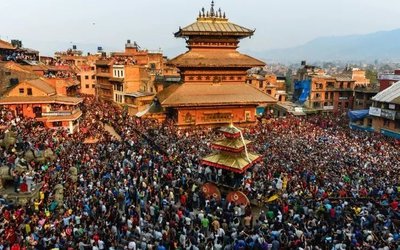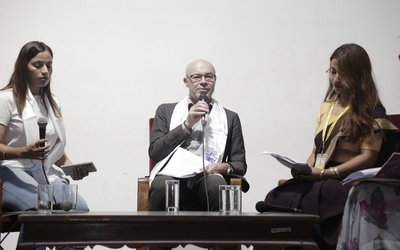
Biska Jatra is one of Bhaktapur’s most popular festivals. The aesthete considers it to be one of the city’s most valued festivals, with both cultural and historical significance.
The anecdote about the Biska Jatra
People welcome Basanta, or spring, through this Jatra, which is held in mid-April. Biska Jatra is the largest jatra celebrated in Bhaktapur. It is celebrated for eight nights and nine days, thus, is also known as the Chyacha Gunhuya Jatra, which translates to “eight-night and nine-day jatra.”
This jatra is also known as Bisket Jatra and Vishwodhoj jatra.
This might be the craziest festival that you have ever seen. The craze of people for this festival is just indescribable. Just to attend this festival, thousands of people from different parts of the country gather at Bhaktapur. There will be this many people that you can’t even surmise.
It feels like the whole city is desolate and all people are in the streets of Bhaktapur.
Rise and fall of Lyo sin dyo
The main attraction of this Jatra is the lyo sin dyo. That is also pronounced as lingo. It is a sky-high unbending pole that locals erect on the last day of the month, Chaitra. And then lie down in the next eve. Somehow, this process of lying the lingo down is well known as the Satruhanta Jatra which means seeing the downfall of your enemy.
There is a common belief that whoever sees the lingo lying down to the earth, their enemy also meets the fall.
This event falls on the very first day of the new year of Bikram Sambat (BS). That means Nepali new year, where the fact is that this biska jatra has no relation with the Nepalese new year. However, the day is also preferred as Vaishaka Sakranti, Mesha Sakranti, or Bisket Sakranti, besides Biska Jatra.
Tug of war
Admittedly, the Malla kings had heightened the importance of Biska jatra by adding a chariot festival to this event. People assemble and collide with the chariot of Bhairava and Bhadra kali against each other during the festival.
The tug of war that will ensue as people pull the unequal number of ropes is thus biased toward the forward direction.
This compensates in part for the comparative difficulties of the terrain in the two directions of the tug of war.
Promptly, a tug of war begins to determine to which half of the city the chariot will go first. It is considered that the presence of the chariot represents a Darsana, a manifestation or “showing himself” of the deity Bhairava to that city half. The men from the lower half of the city try to pull the chariot out of Taumadhi Square into and along the Bazaar street to the south and then west as far as the Tekhaco twa.
The people from the upper city try to pull it out of the square along Bazaar street to the north and east into their half of the city as far as Dattatreya Square. Moreover, the tug of war is the most dangerous part of this event which made out this festival one of the most dangerous festivals in the world.
The festival is celebrated every year for three days but it seems more prominent on the second day of Baisakh and is celebrated as part of Biska Jatra. The festival welcomes the Nepali New Year and marks the arrival of the spring season.
During the festival, devotees gather and take out a procession carrying 32 chariots containing the idols of several gods and goddesses in Madhyapur thimi. People smear each other with Sindoor (orange vermillion powder) as in the Holi festival and sing and dance to the tune of traditional music during the procession.
Tongue-piercing Festival
Each year, on the second day of the Nepalese New Year, Bode witnesses a tongue-piercing ceremony. One resident spends the whole day with an iron spike piercing his tongue and roams the city carrying multiple fiery torches called Mahadip on his shoulder.
As per the locals, this practice will bring good luck to the city. It is believed that with this act being done, there will be the blessing of god bestowed upon them. As a result, there will be no drought or excessive rain, no shortage of food, and any kind of illness.
According to tradition, only the locals of Bode from the Shrestha clan can volunteer to get their tongue pierced.
The tongue piercing festival is one of the famous festivals of the nation run at the community level bearing the entire financial burden. It is believed that king Jagajyoti Malla started the festival and it had been popular since then.
Note: The historical Malla era festival was canceled during the third plague in 1855 for the first time.
The anecdote about the Biska Jatra
Some anecdote states that King Jagat Jyoti Malla first started this jatra. It is said that he was so impressed by the story of serpents that it inspired him to recreate it as a Jatra.
As per the story, there was a cursed princess who became a widow right after the next day of her marriage. It was a mysterious series of death. Whoever married her used to be found dead the next early but no one knew how he died. In this setting, there came a situation where no one dared to marry her.
But, one day, a prince with tantric power came and get a knot with the princess. He married her despite knowing about the curse. He was a brave person and wanted to solve the mystery of mysterious deaths.
For that reason, he stands awake the whole night. And consequently, he found something very suspicious about the princess. The two serpents steadily came out from her nostrils. Meanwhile, the prince sprightly cut them down into pieces with his swords as soon as he saw them crawling.
Those two serpents were the reasons for all those mysterious death. And this is how the curse was cured. Therefore, to celebrate this victory against those serpents, people start to celebrate Biska Jatra.
This is more like a folklore that we have been hearing from our childhood. However, the actual reason for celebrating Biska Jatra might be more than just a story related to serpents.
Besides this, people also celebrate the jatra of Mahalaxmi, Mahakali, Bramayani, and Maheshwari during the festival.
The details about such events are covered by our photo story session, you could check that out too. It has foremost discussed each event and activity of the Biska Jatra.
- The Situation Pushes Women Journalists To Speak Louder, Experts Emphasize
- Jun 30, 2025
- SPI NEPAL: Prosperity Through Clean Energy
- Jun 30, 2025
- PM Oli Meets Spanish Prime Minister
- Jun 30, 2025
- FM Dr. Rana Said Nepal recognises constitutional guarantees to citizens' right to food
- Jun 30, 2025
- Weather Forecast: Generally Cloudy With Heavy Rainfall Is Likely In One Or Two Places Of Kathamandu, Biratnagar And Pokhara
- Jun 30, 2025















